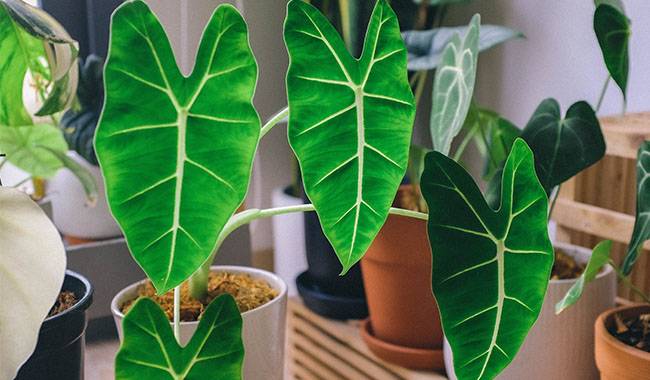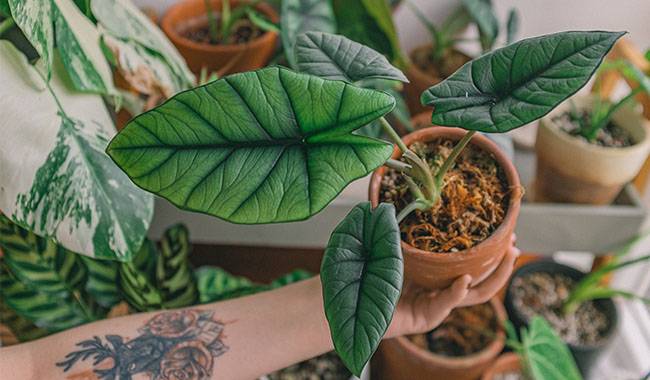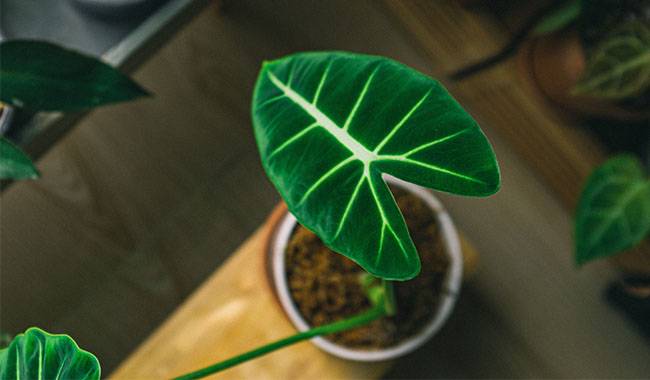
Some people find Alocasias plants hostile and repulsive, while others see them as the ideal of plain perfection. But they certainly don’t leave anyone indifferent. Almost everything about Alocasias is artificial – the bright shine, the perfect shape of the leaves, the thick, pronounced veins that form geometric patterns, even the dark, the almost black color of the leaves. The scale and striking greenery of Alocasias are second to none. However, for such a look, you will always have to pay for the simplest of care. Alocasias love moisture, do not tolerate mistakes and are plants for the experienced and cautious grower.
ALOCASIAS – PLANT DESCRIPTION
Alocasia from the Tenebrionaceae family is convincingly nicknamed for the size and shape of its leaves: elephants, elephant ears, and African masks.
Alocasias rarely grow indoors to 40 inches (1 m) tall and always retain their foliage in winter. They are large evergreen leafy stars with thick, short upright stems and stolons or tuberous rhizomes. If well maintained, a plant will usually have six to eight leaves. The plant produces about one leaf per month.
The leaves are very large, fissured, peltate, densely leathery, 8-12 inches (20-30 cm) to 30 inches (80 cm) long, on strong petioles, 30-60 inches (30-100 cm) tall, with long sheaths. Young leaves’ fuzzy shape and color change to arrow or heart-shaped in adulthood, with very large teeth marks on the margins. The strong sheen of the leaves emphasizes the undulating curve of the surface.
In some species, the color is light and monochromatic. In others, it is almost black with thick contrasting veins. The vein pattern is unusual: the petiole is divided into three central veins (primary and lateral), while the secondary veins create a feathered pattern that merges into a marginal border. The leaves are lined with alocasias – water stomata that release water droplets during over-watering.
Alocasias rarely bloom in rooms. The inflorescence is hidden in a mass of leaves that do not exceed the height of the petiole. A mulch covers the green rods with a slight shrinkage. The hemispheres of red berries are a much rarer sight.
Alocasias, especially the rhizomes, should be handled with great care. Toxic substances can cause both severe irritation and poisoning.
ALOCASIAS SPECIES SUITABLE FOR INDOOR USE

Alocasia sanderiana is one of the most popular varieties, known for its thick white veins on a background of very dark leaf plates, forming a strict pattern. It can grow up to 24 inches (60 cm) tall.
Alocasia cuprea is a compact species with a shortened or subterranean shoot that attracts a metallic effect and a more elongated arrow-shaped leaf shape.
Alocasia lauterbachiana is an interesting tuberous species with lanceolate, pointed, wavy, upward projecting leaves with purple undersides and petioles.
Alocasia odora is a robust species, up to 40 inches (1 m), with a tuberous rhizome and very large, long-petioled, wavy, heart-shaped leaves. It is presented in rooms mainly in a variegated form.
Alocasia longiloba is a unique variegated species that forms underground stolons with purple petioles and dark lanceolate leaves with thick central and thin secondary white veins.
Alocasia zebrina is an interesting species with spear-like brown-striped leaves and very fine and tall petioles.
Alocasia venti (Alocasia wentii) is a large species with shortened stems and bronze-colored heart-shaped leaves.
Alocasia mortfontanensis, still known as Alocasia amazonica, is a hybrid species with wavy leaves, contrasting veins, and shortened stems.
The variety range of Alocasias continues to expand with less capricious, compact hybrids and interesting colors.
“Alocasia Polly” is a variety of dark leaves and small foliage with the thickest white veins.
“Alocasia Calidora” is a light-leaved, wrinkled hybrid.
“Alocasia Portodora” is a glossy, bright green hybrid with serrated margins.
“Alocasia cuprea Red Secret” is a copper-colored variety with a pinkish sheen, burgundy underside, and sunken, feathery, dark green veins.
“Alocasia Bambino‘ is a compact variety with neat, lance-shaped, firm leaves and very thick white veins.
“Alocasia Silver Dragon” is a silvery gray, red-backed arrowleaf hybrid.
“Alocasia Black Velvet” is a compact plant up to 12 inches (30 cm) in height with almost round, wavy black-green leaves with fine, luminous stripes and a lavender underside.
“Alocasia Dragon Scale” is a light-leaved variety with fine veins – dark on top and purple underneath.
If you have room to grow hoodia in a large greenhouse, consider giant hoodia – leaves up to 40 inches (1 meter) tall or edible hoodia (leaves are short and pointed).
GROWING CONDITIONS FOR ALOCASIA INDOORS
Alocasia’s tropical needs are more easily met in a greenhouse or floral display case. Plants in the living room are particularly affected from autumn to spring. They need to be kept warm and compensated by light.
Lighting and Placement
Alocasia prefers a steady and constant soft light and does not need direct sunlight. In summer, it is best to place them in a soft half-space, on a northern windowsill or near a brighter window, and in winter – on the sunniest windowsill to compensate for the shortened daylight hours. Green-leaved plants are more shade-tolerant, while potted plants are pretty light-loving.
Temperature and Ventilation
Alocasias are very thermophilic, and it is best to limit the minimum temperature to 64-66 °F (18-19 °C) even in winter. A year-round temperature of 68-71 °F (20-22 °C) for hybrids and 71-77 °F (22-25 °C) for Alocasia varieties is ideal for this crop, as it does not tolerate instability.
Alocasia needs year-round protection from draughts and temperature extremes. Therefore, the location should be protected, warm and stable.
CARING FOR ALOCASIA AT HOME

Maintaining light but constant substrate humidity and very high air humidity is not easy, but it is the only way to create perfect care for Alocasia.
Watering and Air Humidity
Even slight over-watering can lead to root rot, while dryness can cause leaves to fall off. Water in the tray must not stand still for too long and must be poured out immediately. To determine the best watering frequency, it is best to get a watering meter or touch the soil directly after 2 inches (5 cm) has dried out to check the dryness (after winter).
Water these plants with only mild, slightly warm water. Alocasia requires frequent spraying, but usually only by installing a humidifier, a hood, a cabinet, a flower room, or at least – a tray with pebbles – can you create a sufficiently stable humidity level. The optimal humidity level should not be less than 75%.
Please keep it clean and wipe the leaves from dust with a soft, damp sponge or cloth at least once a week.
Feeding and fertilizer composition
Alocasia plants are suitable for cultivating Alocasia plants only but can be replaced with succulent fertilizer or half dose of ornamental foliar fertilizer. A regular fertilizer (once every two weeks, in spring and summer) or a long-lasting fertilizer (as directed) will do the job. Alocasias plants should not be fertilized in the fall or winter.
Pruning, transplanting, containers and substrates
Please do not cut off the leaves until they turn yellow (as with bulbs).
It is best to transplant even young Alocasia every two years rather than annually as the root system grows. The safest time to do this is in the early stages of growth, February-March.
Special substrates suitable for embroidered or epiphytic plants are ideal – coarse, fibrous, and slightly acidic. You can use orchid soil mixed with a general-purpose substrate and peat soil. When mixing a homemade clay mixture, you can combine 2 parts of leaf soil, 1 part of a peat or coconut substrate, 1 part of sod soil, 1 part of peat, and 1 part of coarse sand, adjusting the texture with bark.
Alocasias need fairly tight, deep pots with good drainage holes. The step to increase the container when transplanting is 1 inch (2.5 cm).
Make sure to place a high drainage device at the bottom – about 2
Alocasias should be transplanted with the root ball intact. The top of the tuber is left above the soil.
Pests and problems in Alocasia planting
All problems are connected with violation of stability of conditions – high temperature and high humidity, irregular watering.
Alocasia is greatly affected by spider mites, especially red mites. However, aphids, thrips, and whiteflies are not uncommon on plants in a weakened state. Tomato leaf infusions and biological insecticides are the best options for controlling them. However, if these do not stop the rapid spread of insects, it is worth treating them with chemicals.
Reproduction of Alocasias
The options for producing offspring depend on the condition and age of the plant. The easiest way is to wait for the alocasia to grow, produce shoots, and wait for the resulting large number of sub tubers to grow leaves – separating the strong offspring with their roots when replanting.
If you don’t want to wait, tiny offspring without roots and leaves can be rooted separately by picking them out of the soil or by removing them from the roots when replanting. They are grown in a greenhouse, under a hood, or in a closed container, in sphagnum soil, perlite, or light soil for rooting. Lower heating, higher air humidity, and very careful watering are desirable.
Once the roots have emerged, plant the plants in small pots (slightly larger than the tubers themselves) according to standard rules, followed by transplanting after the roots have fully developed the substrate.
For dying plants, stem cuttings or plugs for rooting are an option. This is a tricky method, as is rooting the lowest, oldest leaves with petioles. After drying and treating the plugs, they are rooted in a substrate under mulch under the same conditions as the tubers.
Seed propagation does not preserve varietal characteristics and is difficult to obtain. Seeds are harvested fresh and sown shallowly in a greenhouse at 73-75 °F (23-24°C) and high humidity. Seedlings will be harvested repeatedly as the roots grow.







